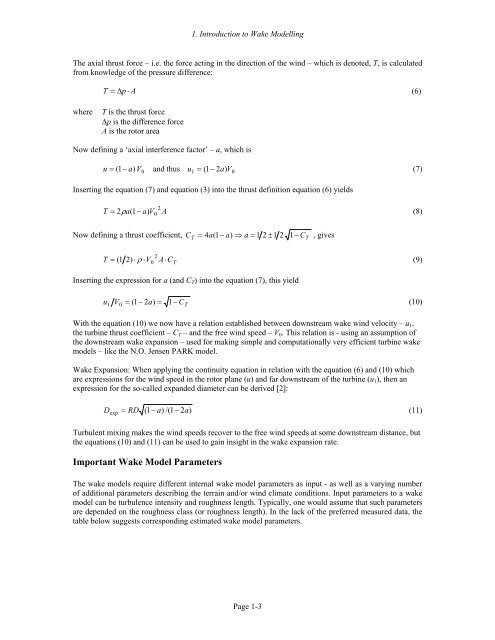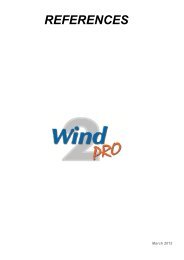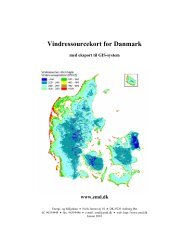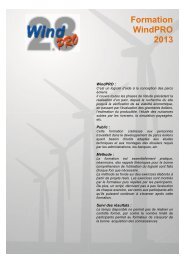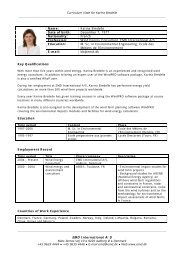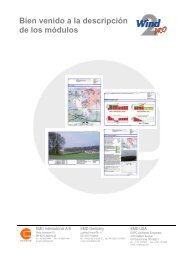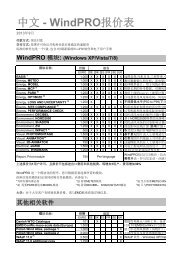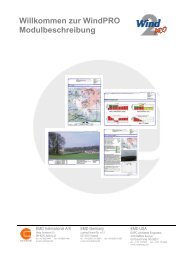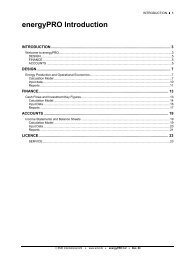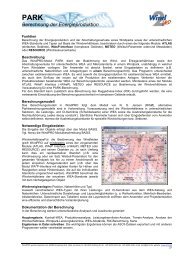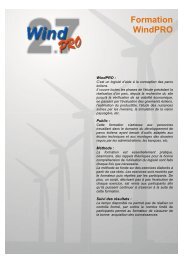WindPRO / PARK - EMD International AS.
WindPRO / PARK - EMD International AS.
WindPRO / PARK - EMD International AS.
You also want an ePaper? Increase the reach of your titles
YUMPU automatically turns print PDFs into web optimized ePapers that Google loves.
1. Introduction to Wake Modelling<br />
The axial thrust force – i.e. the force acting in the direction of the wind – which is denoted, T, is calculated<br />
from knowledge of the pressure difference:<br />
T = ∆p<br />
⋅ A<br />
(6)<br />
where<br />
T is the thrust force<br />
∆p is the difference force<br />
A is the rotor area<br />
Now defining a ‘axial interference factor’ – a, which is<br />
u = ( 1−<br />
a)<br />
V<br />
V<br />
(7)<br />
0 and thus u1<br />
= (1 − 2a)<br />
Inserting the equation (7) and equation (3) into the thrust definition equation (6) yields<br />
0<br />
T = 2ρa(1<br />
− a)<br />
V<br />
2<br />
0<br />
A<br />
(8)<br />
Now defining a thrust coefficient, C<br />
T<br />
= 4 a(1<br />
− a)<br />
⇒ a = 1 2 ± 1 2 1−<br />
C , gives<br />
T<br />
2<br />
0<br />
T = ( 1 2) ⋅ ρ ⋅V<br />
A⋅<br />
(9)<br />
C T<br />
Inserting the expression for a (and C T ) into the equation (7), this yield<br />
u<br />
1 V0<br />
= (1 − 2a)<br />
= 1−<br />
C T<br />
(10)<br />
With the equation (10) we now have a relation established between downstream wake wind velocity – u 1 ,<br />
the turbine thrust coefficient – C T – and the free wind speed – V 0 . This relation is - using an assumption of<br />
the downstream wake expansion – used for making simple and computationally very efficient turbine wake<br />
models – like the N.O. Jensen <strong>PARK</strong> model.<br />
Wake Expansion: When applying the continuity equation in relation with the equation (6) and (10) which<br />
are expressions for the wind speed in the rotor plane (u) and far downstream of the turbine (u 1 ), then an<br />
expression for the so-called expanded diameter can be derived [2]:<br />
D<br />
exp<br />
= RD (1 − a)<br />
/(1 − 2a)<br />
(11)<br />
Turbulent mixing makes the wind speeds recover to the free wind speeds at some downstream distance, but<br />
the equations (10) and (11) can be used to gain insight in the wake expansion rate.<br />
Important Wake Model Parameters<br />
The wake models require different internal wake model parameters as input - as well as a varying number<br />
of additional parameters describing the terrain and/or wind climate conditions. Input parameters to a wake<br />
model can be turbulence intensity and roughness length. Typically, one would assume that such parameters<br />
are depended on the roughness class (or roughness length). In the lack of the preferred measured data, the<br />
table below suggests corresponding estimated wake model parameters.<br />
Page 1-3


